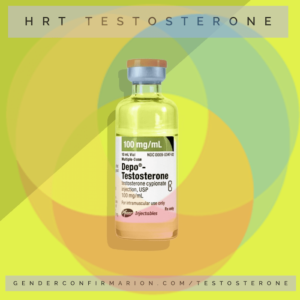Testosterone: For Transmen, Transmasculine, Non-Binary and Gender Expansive Folks

It is important for you to strongly consider that this page is not medical advice. This page is meant to be informational only. Our doctors does not prescribe testosterone. Starting hormones or changing your hormone regimen or dose may cause harm, and should only be done after a conversation with a medical doctor. Please seek guidance from your primary care physician or hormone specialist before you go on hormones or consider an adjustment to your hormone regimen.
Testosterone (T) hormone replacement therapy (HRT) is used to suppress assigned female at birth secondary sex characteristics in addition to providing ‘masculinizing’ effects such as facial hair, body hair, deepening of the voice, fat and muscle distribution. Transmen, transmasculine, non-binary, and gender expansive folks may seek HRT Testosterone treatments to alleviate dysphoric feelings. Cross-sex hormone therapy (i.e, in this case, taking testosterone) has been shown to have positive physical and psychological effects due to a variety of factors. Some may feel that being able to develop characteristics that are more aligned with the gender they identify with helps with gender dysphoria. Read our page on microdosing testosterone to learn more about what it means to microdose.
How to Get Testosterone as a Transgender or Gender Expansive Person
As a first step, many trans, non-binary, and gender expansive folks might want to take their time contemplating whether or not testosterone therapy would be a good fit for them. Familiarizing yourself with the reversible and irreversible effects of testosterone, as well as the common timeline for changes, can be a great place to start. Patients who are interested in having some of the changes that testosterone brings, but would like them to occur at a slower pace, can ask their provider about microdosing testosterone as an alternative.
The process for obtaining testosterone can seem a little daunting at first. At this time, we do not provide any form of hormone therapy at the Gender Confirmation Center (GCC). However, patients can search for gender-competent HRT providers in the following directories:
- Plume and Folx Health: both online, telehealth providers of HRT and other healthcare services for trans, non-binary, and gender expansive folks.
- WPATH: search “Endocrinology”
- LGBTQ+ Healthcare Directory: search “Gender Affirming Hormone Therapy”
- Southern Equality: for providers in the US South, search “Endocrinology”
- Outcare: search “Endocrinology”
Please note that providers may have different requirements for patient eligibility. For some adult patients only need to undergo an informed consent process wherein after being educated about the effects and risks of HRT, they can decide whether or not they want to initiate treatment. Other healthcare or insurance providers may ask you to provide a letter of support from a licensed mental health professional to start your treatment and/or provide insurance coverage for it.
Types of Testosterone
Once your primary care doctor has agreed that testosterone is the next step it’s good to be aware of what your options are. Below is a list of methods of taking testosterone:
Testosterone Injections: This is the most popular and cost-effective method of delivering testosterone. If you’re going the injection route, that would mean your testosterone is prescribed in liquid form. Injections are given either Intramuscularly (injected into the muscle) or subcutaneously (injected into the fat). Whether you choose intramuscular or subcutaneous is a personal preference, and most doctors will be willing to discuss the best choice for your dosing and frequency of these vary, but it is common for injections to be administered either every week at a smaller dose or every 2 weeks at a larger dose.
Testosterone Skin Patch, Gel, or Cream: This is known as transdermal application. This method is less effective, more expensive and less likely to be prescribed. Application would need to be on an area of the skin that isn’t exposed to others as to not transfer testosterone onto them.
Pill: Only available in Europe as of 2018
Testosterone Dosing for Transgender & Non-binary Folks
Finding the right dose for you is dependent on what your goals are. There is no ‘one’ clinical protocol for testosterone therapy, therefore it’s important to be clear about your goals. If your goal was to pass as male then the doctor would know to put you on a high dose. If you express that you don’t want to pass as male but you want to appear more masculine than you are presenting currently, then they’d be more likely to start you out on a lower dose. Your doctor could start you on a lower dose if you have chronic health problems or have had your ovaries removed.
As far as the frequency of your dose goes ask your doctor about the different between weekly injections v.s bi-weekly injections. Some folks opt for weekly injections as to not experience as intense peaks and troughs.
‘Peak’ and ‘Trough’ Explained
Peak and trough are terms that aren’t exclusive to hormone replacement therapy. However, for the purpose of this content we’ll be using it in relation to HRT.
- Trough: Is the lowest level of concentration that your T levels would be at in your dosing cycle. Meaning that if you injected once every 2 weeks on day 12 or 13, you may experience a ‘dip’ in your hormone levels. During this dip, you could feel lethargic or irritable
- Peak: Is the highest level of concentration and would occur on the day you administer your shot. During this peak, you may feel energized and happier
Folks experience with peaks and trough’s vary as it all depends on how your body responds to T. Some folks have very intense peaks and troughs and others not. For folks who experience dramatic peaks and troughs while on T you may want to speak to your doctor to see if a weekly shot (v.s bi weekly) at a lower dose could alleviate these symptoms.
Typical Changes While Taking Testosterone
There are 2 types of changes that will occur while on T: reversible and irreversible.
The reversible changes that regress once you’ve stopped taking T are: Muscle-fat redistribution (mostly around the hips, thighs and stomach), coarser skin, body odor, acne, oily and thicker skin.
The irreversible changes after going off of T are: Male-pattern baldness, voice drop, facial and body hair, and genital growth.
It’s important to note that testosterone effects everyone different, so You can’t pick the changes you want, so before deciding make sure you’d be ok with the changes that can take place. Your primary care physician will also go over the risk and benefits of T prior to giving you a prescription where you are also obliged to sign that you have been read and understand the changes that can take place.
Timeline of Changes after Starting HRT Testosterone
The items listed below are ‘general timeframes and vary from person to person. The timeline has been taken from Hormones: A Guide for FTMs.
1–3 months after starting T:
- Increased sex drive
- Vaginal dryness
- Growth of your clitoris (typically 1–3 cm)
- Increased growth, coarseness, and thickness of hairs on arms, legs, chest, back, & abdomen
- Oily skin and increased acne
- Increased muscle mass and upper body strength
- Redistribution of body fat to a more “masculine” pattern (more fat around the waist, less around the hips)
1–6 months after starting T:
- Menstrual periods stop
3–6 months after:
- Voice starts to crack and drop within the first 3–6 months, but can take a year to finish changing
1 year or more after starting T:
- Gradual growth of facial hair (usually 1–4 years to reach
full growth)
- Possible “male”-pattern balding
Myth Busting Testosterone
There internet’s a really big place with a lot of information. Some of the information can be dated, so make sure you double-check whatever you read.
- Taking Testosterone will give me cancer
- There’s no solid evidence that you’re at an increased risk of cancer. There hasn’t been enough transgender research to identify the risks of transmen on testosterone
- Taking testosterone will make me fat
- No, the effects of testosterone won’t necessarily make you fat
- T affects your hormones, which affects your metabolism. T speeds up your metabolism, so you may become hungrier, and if you don’t eat right, you can gain weight. On the other hand, the rate at which you’re able to burn food off is also increased
- Over the course of months and years, folks on T usually see a shift of body fat from the hips and legs to the stomach. When you start to develop a ‘gut’, it can feel at first like you’ve gained weight
- Your muscle mass will increase, so your clothes may start to become too small, which can also lead to feelings of ‘gaining weight’
- Again, there isn’t enough research yet on the trans masculine population, so new studies could unearth new information
- If I stop taking testosterone after top surgery, my breasts will grow back
- If the surgeon who has done your top surgery did a good job of removing as much of the fatty tissue, ductal/glandular tissue, then there would be nothing (or little) to ‘grow back’
- If there was fatty tissue left behind,d it could go through phases of shrinkage and growth, but usually not at a rate that would cause breasts to ‘grow back’
- If you discontinue T and have functioning ovaries, the redistribution of fat could include a small fat increase in the chest, but not a significant amount
- If I go on a high dose of testosterone, I will transition faster than if I were on a ‘regular’ dose (or low dose)
- The opposite can actually occur. Meaning your body may take that excess T in your body and convert it into estrogen, which happens so your body can maintain a ‘normal’ hormone balance. Patience is paramount
- Conclusion: Discuss and follow the dosing that you and your doctor have agreed upon. Don’t attempt to higher or lower your dose unsupervised
- Testosterone will make me aggressive and irritable
- Mood changes will occur, some of which could be feeling more aggressive or irritable. However, it won’t happen overnight, and at the end of the day (despite all the changes) you’re still you
- You could experience feeling calmer or more centered as you come into yourself more
- Finding a gender affirming therapist can help you process the emotional challenges that T can present. Here is a good place to start if you’re interested in finding a therapist who works with the LGBTQ community
- The changes that occur while I’m on testosterone will stop within 2 years
- Although some of the ‘rudimentary’ changes occur within the first 2-4 years, your body and facial hair will continue to develop over the next ten years as you age
- I need to be on testosterone in order to get F2M surgery, or non-binary FTN top surgery
- It’s not a requirement of our doctors to be on testosterone to get top surgery
- Some insurance companies may require it
- Some surgeons may require you to be on T to get top surgery
HRT Testosterone In Conclusion
It’s important to remember hormone replacement therapy isn’t linear, there can be lots of beautiful twists and turns. There’s no ‘right’ or ‘wrong’ way to transition as long as you’re doing it in a way that is safe and comfortable pace for you. Your alignment can be whatever you want it to be and everyone’s is unique and beautiful.




